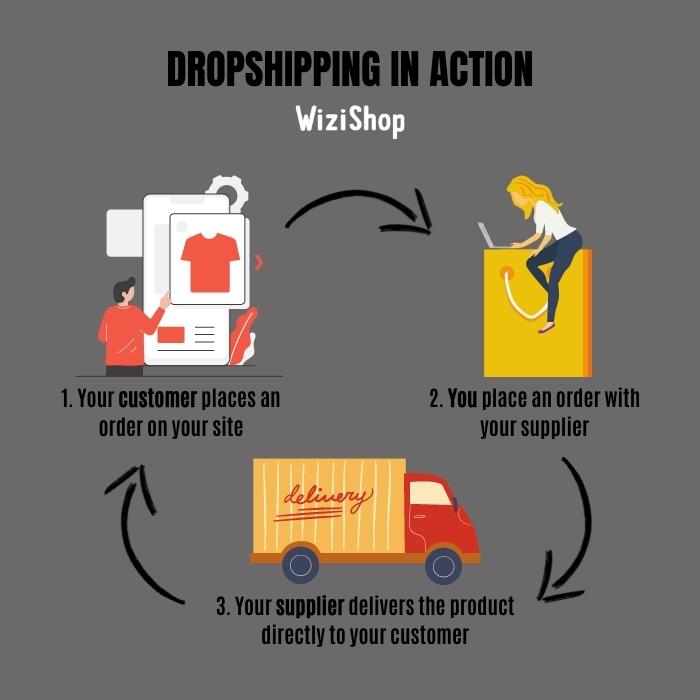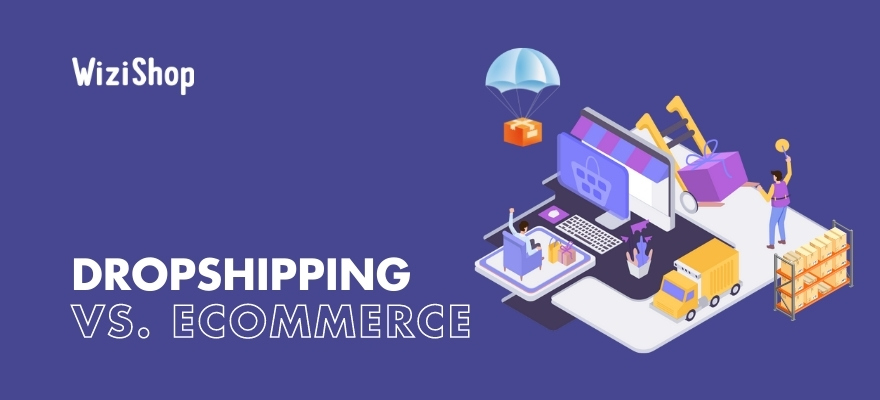Embarking on the adventure of the ecommerce may seem tempting in many ways... It’s true that it’s a growing sector of activity, which continues to expand its popularity and offers many opportunities to seize.
Starting a business is a dream for many people. But how do you make it work? Many future entrepreneurs start their own online store. But which model is best for your brand? Ecommerce? Dropshipping? Which product, which suppliers to choose, which type of business, for which customer, and at what price?
Many questions arise in the minds of future e-merchants or dropshippers, well before launching their business. Sales websites, marketplace platform, dropshipping service... What type of solution should you choose for your business according to your objectives?
There are two types of models for online sales: ecommerce and dropshipping. Your business will then take a different path depending on your choice.
Ecommerce and dropshipping: definitions
What is ecommerce?
Ecommerce is the equivalent of traditional commerce on the internet. Ecommerce puts a customer in contact with an online store via the internet.
This e-merchant is either a creator, i.e., they create the product they sell, or they call upon suppliers and present their stock from these suppliers on their sales website.
In terms of order fulfillment, for the customer to receive their item, the store will ship its packages from its inventory, a model that implies a delivery time, which is generally between 24 and 48 hours or in less than 5 days.
When we talk about ecommerce businesses, their websites have all the items they sell in stock. They have their own warehouses to store their inventory, which allow them to sell products that the merchants have manufactured themselves or that they’ve purchased from their suppliers.
In the same way, ecommerce can consist of selling directly with your own online store or being present on marketplace like Amazon.
Selling online has changed significantly since online shopping was first created. Today, ecommerce’s importance is greater than ever and continues to grow year after year.
According to Statista figures, ecommerce reached record amounts in 2021. Driven by digitalization, global sales from ecommerce increased about 22.7% in one year, reaching approximately 5.2 trillion U.S. dollars. Statista data also shows that in 2021, ecommerce made up almost 19% of all retail sales worldwide.
What is dropshipping?
Dropshipping is another, more recent ecommerce model. Its specificity? This type of ecommerce consists of selling products without having any inventory. In other words, this process involves just-in-time production.
The sold products are directly shipped by the external suppliers, but the pricing and marketing are managed by the company at the origin of the sale.
When it comes to order fulfillment for dropshipping, when the customer goes to the ecommerce website, they place their order as on a traditional online sales website. Until then, absolutely nothing changes for them. When the order is validated, the seller contacts their supplier and places exactly the same order as the customer. They then send the product directly from the wholesaler's warehouse to the end customer.

In this context, you can easily understand the importance of choosing your suppliers with the utmost care. They’re the ones who store the products, who check the quality of the items you sell before they’re sent, and who ensure the speed of shipment. All of these tasks are completely out of your control.
Furthermore, in order to limit transportation time and optimize your business’s fulfillment process, it’s better to choose a supplier with warehouses nearby or wholesalers offering a short delivery service. It’s with this precise model and this search for quality that dropshipping still has a future ahead of it.
Today, dropshipping is considered a lucrative business for web companies working with the right wholesalers and suppliers, imposing fewer logistical and financial constraints than traditional ecommerce.
Dropshipping: what are the differences compared to ecommerce?
For the reasons previously mentioned, dropshipping is a method of selling on the internet that’s attracting more and more entrepreneurs. Let's see what its advantages for web retailers are in detail.
The absence of logistics
As you can see, with dropshipping, sellers don’t need any storage space to hold their products and to start their business. This is one of the biggest advantages of dropshipping.
Moreover, it proves to be all the more profitable as your activity grows and as your number of product orders increases. In addition, this lack of logistics is particularly comfortable during certain periods of the year, when sales tend to increase periodically.
It’s important to note that since you don't store the products, you can't discount your products in dropshipping.
Let's take Christmas as an example. During this period, sales on the web tend to double. Many online stores have to invest in larger storage spaces to store their stock and to respond to all their orders. For dropshipping businesses, this is unnecessary!
Your supplier takes care of managing this influx of customers for you. With this system, the suppliers take the relay between the customer and you (the seller) so that the product is delivered in the best way.
Since everything is facilitated in terms of logistics, you no longer need to manage staff or handle anything.
Everything is delegated to your supplier, and you set the prices of the products put on sale on the web so that you can earn a profit, within the limits of the market prices and those advised by your supplier.
From then on, all you have to do is concentrate on your core business: offering products for sale!
Dropshipping allows you to refocus on your core business and not to be overwhelmed by a multitude of other tasks. This is a significant time saver for the seller.
In terms of online sales, you should know that there is now an alternative to dropshipping: Amazon FBA. It’s an automated delivery service offered by the ecommerce giant, the marketplace solution specially designed for companies selling on the web. More concretely, through this intermediary, the seller sends their goods to Amazon's warehouses.
Their items are also offered on the marketplace, which takes care of selling them and delivering the orders. This is an interesting solution for any seller who wants to avoid storing inventory at home, while benefiting from increased visibility for their products. What's more, Amazon is a recognized player in global ecommerce. It’s therefore a trusted intermediary for shipping your business’s items.
A lucrative business
Since sellers don't need to store the products they display on their websites, this gives them the ability to offer more goods and maximize their profit margins without spending more. With dropshipping, they don't need to advance a single cent! These retailers buy only when their customers have finalized their product orders.
Although there’s no limit to how much you can make in ecommerce in general, from a financial point of view, dropshipping offers a significant advantage: entrepreneurs don’t take any financial risk. They don’t have to buy the products they plan to sell beforehand.
In fact, dropshipping allows entrepreneurs to reduce their fixed assets, therefore making it possible to keep certain costs associated with traditional ecommerce businesses very low or eliminate them completely. In other words, since these retailers have no inventory, they have no money tied up in a warehouse or other storage space. It’s therefore a very simplified financial management.
By offering quality items and implementing a good marketing and communication strategy, dropshipping retailers can really earn money and even save a lot of costs compared to traditional ecommerce entrepreneurs.
A freedom-filled activity
If you’re a globetrotter and looking to become an online retailer, dropshipping may be for you! Since you’re not attached to any stock or fixed warehouse, you’re free to work wherever you want.
Dropshipping even allows you to work as a digital nomad, a status created with the internet that involves moving around the world while working on the web. Sell products from anywhere in the world, and let your suppliers take care of the fulfillment aspect for you!
Of course, starting the adventure of ecommerce requires investment. You will find that you will have to work many hours if you want to complete your project. On the other hand, in terms of planning, you will be free as a bird.
With dropshipping, live where you want and work the hours that suit you best!
A first step in online sales
Finally, if you’ve been tempted for a long time by the adventure of ecommerce but you don't dare to take the plunge, dropshipping is an excellent initial experience, which will perhaps allow you to dip your toes in the water.
It’s an ideal solution to start the adventure without taking too many financial risks.
Thus, it can also be a first step to take before you may move your business to a traditional online store.
In spite of these advantages, it’s important to take some precautions before embarking on this adventure, in order to avoid certain mistakes. First of all, know that the presentation of your website and products you sell is essential to attracting internet users. Thus, take care of your design but also your spelling. Your brand’s e-reputation is at stake!
Never write your product descriptions in a hurry. They’re the ones that replace the sales consultants in a physical store. They must be qualitative enough to improve your website’s SEO while converting your customers to purchase. Lastly, don't forget to position your brand on social networks to be seen by as many internet users as possible and find new customers for your business.










